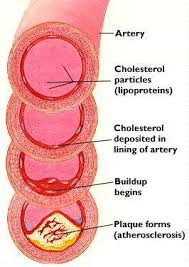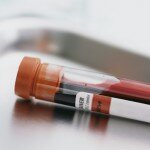 Cholesterol reduction through the use of statin drugs has become a big and profitable business for the pharmaceutical industry. As more and more people have opted for a pill to help control their cholesterol levels fewer people are using fiber as their first line of defense. If you read my blog post http://no-more-heart-disease.com/cholesterol-and-statin-drugs/“Cholesterol and Statin Drugs – Happily Married or Headed for Divorce?”[/intlink] you know that these types of drugs are not without risks.
Cholesterol reduction through the use of statin drugs has become a big and profitable business for the pharmaceutical industry. As more and more people have opted for a pill to help control their cholesterol levels fewer people are using fiber as their first line of defense. If you read my blog post http://no-more-heart-disease.com/cholesterol-and-statin-drugs/“Cholesterol and Statin Drugs – Happily Married or Headed for Divorce?”[/intlink] you know that these types of drugs are not without risks.
So why has the use of fiber declined? For most people compliance is the issue!
This post will provide you with 3 effective steps that can help increase your fiber intake to help in cholesterol reduction!
Background Information!
According to the American Heart Association, http://no-more-heart-disease.com/cholesterol/high cholesterol levels[/intlink] are a major risk factor for the cardiovascular disease atherosclerosis which increases the risk for heart attacks and stroke. The main contributing factor to this problem is LDL (low-density lipoprotein) cholesterol which is commonly called “BAD” cholesterol. Over 100 million Americans have cholesterol levels that exceed the recommended level with 20 percent of these considered in the high category.
Soluble fiber has been clinically shown to reduce LDL cholesterol. The typical American diet has somewhere between 5-14 grams of dietary fiber per day. In 2002, the Food and Nutrition Board of the National Academy of Sciences Research Council issued Dietary Reference Intakes (DRI) for fiber. For males between the ages of 19-50 it is 38 grams of fiber per day. For women in the same age category it is 25 grams of fiber per day. If your age is greater than 50, then the amount of fiber decreases to 30 grams for men and 21 grams for women. At best the typical American is only getting 50% of the needed fiber in their diet.
What is Dietary Fiber?
Dietary fiber is found only in plant foods such as fruits, vegetables, whole-grain breads and cereals, nuts, and legumes (dried beans, lentils and peas). Although there are several forms of fiber, they are usually classified into two groups:
- Soluble fiber can dissolve in water to form a gel-like substance in the digestive tract. This soluble fiber is beneficial in lowering the “BAD” cholesterol. Clinical studies have shown that diets containing 10 to 25 grams of soluble fiber per day can lower LDL cholesterol by 18%. Sources of good soluble fiber include oats, peas, beans, apples, and citrus fruits. Typically one serving of any of these foods will provide about one to three grams of soluble fiber.
- Insoluble fiber cannot dissolve in water so it passes through the digestive tract relatively unchanged. This insoluble fiber helps to make your stools softer and bulkier and speeds elimination. Sources of insoluble fiber would include whole-grain foods, wheat bran, most vegetables and fruit with skin.
Typically, canned and frozen fruits and vegetables contain just as much fiber as raw ones. However, some types of refining processes may reduce the fiber content. Current food labeling requires the amount of dietary fiber to be listed. It is listed just below the “Total Carbohydrate” portion of the Nutrition Facts section of the product label. For a manufacturer to make fiber claims it must meet the following guidelines:
- High Fiber: 5 grams or more per serving
- Good Source of Fiber: 2.5 – 4.9 grams per serving
- More or Added Fiber: At least 2.5 grams more per serving than the reference food
How Fiber Decreases Cholesterol Naturally!
One of the ways the body eliminates cholesterol is through the excretion of bile acids. Water-soluble fiber such as pectin and fiber found in rolled oats helps to bind these bile acids so that they are not reabsorbed in the intestines. This forces the liver to make new bile salts. To do so the liver increases its production of LDL receptors. These receptors then pull LDL cholesterol out of the bloodstream. The more bile salts the liver has to make the greater the amount of LDL cholesterol pulled from the blood. By increasing your fiber intake you increase the amount of fiber available to bind these bile acids to speed this natural cholesterol reduction method.
Soluble fiber also seems to have a secondary method for cholesterol reduction. Although this method is not completely understood it seems that the fermentation of soluble fiber in the large intestines produces several short-chain fatty acids. One of these fatty acids will travel to your liver to tell it to produce less cholesterol.
3 Simple Steps to Increasing Your Fiber Intake!
When most people hear the concept of increasing their fiber intake they immediately think about eating multigrain breads and a lot of lettuce. This is not what their culinary taste buds are going to get excited about. Plus, it’s not the most effective way to increase your fiber intake.
The following 3 steps are realistic so that everyone can achieve the goal of increased fiber intake and be able to do it long term. These steps will help improve your overall health and have the potential to be an effective strategy for cholesterol reduction.
Step 1- Examine Your Diet. You like bread, cereal, pasta, rice, and maybe a vegetable. By making some simple changes you could drastically increase your fiber intake while still enjoying your same meals.
- Bread: 1 slice of white bread has .6 grams of fiber where as 1 slice of whole-wheat bread has 1.9 grams of fiber. Figuring two slices of bread for your sandwich, you just increased your fiber intake from 1.2 grams to 3.8 grams. For a creative change to the normal sandwich try Flatout Wraps. Their Harvest Wheat has 5 grams of fiber per wrap and some of their wraps can go as high as 9 grams of fiber. Go to http://www.flatoutbread.com/ for recipes and store locations.
- Cereal: Maybe you’re a Wheaties type of person which has 2 grams of fiber per 1 cup serving. By switching to 100% All Bran you just increased you fiber intake to 17.6 grams of fiber. Too much fiber and not enough taste than try Raisin Bran at 5 grams per 1 cup serving.
- Pasta: 1 cup of uncooked pasta typically has 2 grams of fiber. Switching to 1 cup of Barilla PLUS pasta and your fiber intake increased to 7 grams of fiber. Add a ½ cup of tomato sauce on top and you added another 3 grams of fiber. What would have been a “5 grams of fiber” meal has now become “10 grams of fiber” with no loss in taste. For more information about recipes and store locations go to http://www.barillaus.com/ .
- Rice: 1 cup of cooked white rice is 2 grams of fiber. Switching to 1 cup of cooked brown rice and you’re at 5.5 grams of fiber.
- Vegetable: Some people think they need to add broccoli or cauliflower to their meal to increase their fiber and it turns them off. Broccoli has 3.0 grams of fiber per cup, cauliflower only has 2.5 grams of fiber per cup. Switching to 1 cup of corn gives you 4.0 grams of fiber, 1 cup of green beans is 4.2 grams of fiber, and 1 cup of peas is 7.0 grams of fiber. Instead of having a salad which has 1 cup of iceberg lettuce at .7 grams of fiber you could skip the salad and add a vegetable that gives you 8 times the value in fiber.
Step 2- Add Fiber. There are a couple of simple ways to add fiber to your daily intake of food without adding loads of calories. This helps control your weight which can also be a factor in cholesterol reduction.
- Breakfast: A medium banana added to the top of your cereal is 3 grams of fiber. A cup of strawberries, blueberries, or raspberries would range from 3.3 to 4.5 grams of fiber.
- Snack: Instead of going to the vending machine for a candy bar or bag of chips why not eat a medium pear at 88 calories and 5 grams of fiber or a large apple at 90 calories and 4.5 grams of fiber.
- Meal: Maybe it’s time to try some new additions to your meal like 1 cup of lentils or black beans at 15 grams of fiber, baked beans at 10.4 grams of fiber, 1 medium baked potato with the skin at 5.0 grams of fiber, or a sweet potato without the skin at 5.5 grams of fiber.
By incorporating some of the changes and additions we’ve looked at you could see the following improvements in your overall fiber intake:
- A breakfast of cereal and toast could go from 1 to 3 grams of fiber to 9 to 21 grams of fiber.
- A mid-morning snack could go from 1 gram of fiber to 4 to 5 grams of fiber.
- A sandwich at lunch could go from 1 to 3 grams of fiber to 4 to 15 grams of fiber.
- A mid-afternoon snack could go from 1 gram of fiber to 4 to 5 grams of fiber.
- A dinner meal could go from 5 to 7 grams of fiber to 9 to 15 grams of fiber.
Just by making some simple changes in your food selection you could go from 9-15 grams of fiber to 30-61 grams of fiber. Just think of the impact this would have on your overall health while you are reducing your LDL cholesterol.
Step 3 – Take a Supplement. There is some controversy in the use of fiber supplements so I add this step with caution. If you are not willing to make the simple changes I have outlined in Steps 1 & 2, then talk with a qualified physician who can give you some guidance in this area. Typically, one tablespoon of an over-the-counter fiber supplement has 15 grams of fiber. Most people take their supplement at night after their evening meal.
Supplements are not meant to be used as a laxative which is where most of the controversy occurs. They are only meant to be used as a supplement for those who are not getting the proper amount of fiber from their diet.
Two Important Notes!
Proper water intake is fundamental to this whole process of fiber intake. On the one hand, fiber can be extremely useful in preventing constipation. But, fiber taken in the absence of adequate water intake can also be binding to cause severe constipation. Proper water intake is the number one key to improving your overall health and wellness.
Due to its complexity, laboratory technicians have not yet been able to ascertain the exact fiber content of many foods. Because of this, you may find discrepancies from one fiber source to another. Add to the fact that there are varying sizes of fruits and vegetable, as well as growing conditions, and you can begin to understand why there might be some variations in the number of grams of fiber listed for different food items.
If you are not use to eating high fiber foods then make your changes gradually to allow your body to adjust. Anyone with a chronic disease should always consult their physician first before they alter their diet.
As you can see, increasing your fiber intake can have a positive effect on cholesterol reduction. With guidance, and using some simple steps to incorporate more fiber into your diet, you can get Randy from American Idol to say, “It’s the Bomb, Baby!”
Together we can work to save a million lives!
Dan Hammer


 Happily Married or Headed for Divorce?
Happily Married or Headed for Divorce?